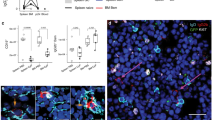Abstract.
Recent findings suggest that lymphocyte survival is a continuous active process and support the role of B cell receptor engagement in B cell survival. In this context the conflict of survival interests between the diverse B cells gives rise to a pattern of interactions which mimics the behavior of complex ecological systems. In response to competition lymphocytes modify their survival requirements and diverge to occupy different immunological niches through differentiation. Thus naive and memory-activated B cell populations show independent homeostatic regulation. We discuss how niche differentiation allows the coexistence of different cell types and guarantees both repertoire diversity and efficient immune responses.
Similar content being viewed by others
Author information
Authors and Affiliations
Additional information
Received 3 December 1999; accepted 18 February 2000
Rights and permissions
About this article
Cite this article
Agenès, F., Rosado, M. & Freitas*, A. Peripheral B cell survival . CMLS, Cell. Mol. Life Sci. 57, 1220–1228 (2000). https://doi.org/10.1007/PL00000761
Issue Date:
DOI: https://doi.org/10.1007/PL00000761




